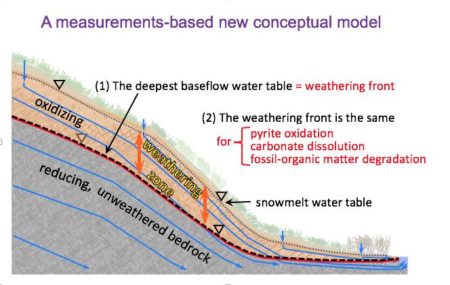
The new conceptual model coupling subsurface water table positions with weathering fronts of multiple minerals and components in sedimentary bedrocks. The water table remains approximately parallel to the soil surface along the hillslope. The deepest seasonal water table determines the pyrite weathering front. Carbonate minerals and fossil-organic matter share the same weathering front with pyrite.
For the first time, subsurface bedrock weathering rates were directly determined from in-situ measurements. The weathering front coincides with the depth of deepest seasonal water table for sedimentary bedrocks. Carbonates and rock organic matter share the same weathering front depth with pyrite, contrary to models that stratify their weathering fronts.
This new conceptual model linked to subsurface hydrology makes predictions of bedrock weathering fronts and rates more feasible, and connects to water quality and climate change impacts. The approach can be applied to other settings of a watershed.
Summary
Although bedrock weathering strongly influences water quality and global carbon and nitrogen budgets, the weathering depths and rates within subsurface are not well understood nor predictable. Determination of both porewater chemistry and subsurface water flow are needed in order to develop more complete understanding and obtain weathering rates. In a long-term field study, this study applied a multiphase approach along a mountainous watershed hillslope transect underlain by marine shale. Three findings are reported in the study. First, the deepest extent of the water table determines the weathering front, and the range of annually water table oscillations determines the thickness of the weathering zone. Below the lowest water table, permanently water-saturated bedrock remains reducing, preventing deeper pyrite oxidation. Secondly, carbonate minerals and potentially rock organic matter share the same weathering front depth with pyrite, contrary to models where weathering fronts are stratified. Thirdly, the measurements-based weathering rates from subsurface shale are high, amounting to base cation exports of about 70 kmolc ha−1 y−1, yet consistent with weathering of marine shale. Finally, by integrating geochemical and hydrological data, a new conceptual model is presented that can be applied in other settings to predict weathering and water quality responses to climate change.
Citation
Wan, J., Tokunaga, T. K., Williams, K. H., Brown, W., Dong, W., & Hubbard, S. S., Predicting sedimentary bedrock subsurface weathering fronts and weathering rates. Scientific Reports, 2019, DOI: 10.1038/s41598-019-53205-2
